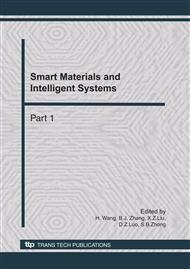[1]
B. Dasgupta, T. S. Mruthyunjaya. Singularity-Free Path Planning for the Stewart Platform Manipulator. Mechanism and Machine Theory, Vol. 6(1998), pp.711-725.
DOI: 10.1016/s0094-114x(97)00095-5
Google Scholar
[2]
G. F, Liu, Y. L, Wu and X. Z. Wu. Analysis and Control of Redundant Parallel Manipulators. IEEE International Conference on Robotics & Automation, Seoul, Korea, (2001).
Google Scholar
[3]
J. X. Yang, Y. Q. Yu. Actuator Singularity Analysis of Planar 3-DOF Redundant Parallel Mechanisms. China Mechanical Engineering , Vol. 6(2006), pp.629-632.
Google Scholar
[4]
Y. L. Wu. Study on Differential Geometry Theory of Singularities of Parallel Manipulators and Redundant Parallel Manipulators. Changsha: National University of Defense Technology, pp.75-79.
Google Scholar
[5]
Y. F. Zhang, J. L. Gong and F. Gao. Theory of Singularity Elimination by Redundant Actuation for Parallel Mechanism. China Mechanical Engineering , Vol. 5(2006), pp.445-448.
Google Scholar
[6]
D. Stewart. A Platform with Six Degrees of Freedom. Proc. of the Institution of Mechanical Engineers Part C: Journal of Mechanical Engineering Science. Vol. 180 (1965), pp.371-378.
DOI: 10.1243/pime_proc_1965_180_029_02
Google Scholar
[7]
C. M. Gosselin, J. Angeles. Singularity Analysis of Closed-Loop Kinematic Chains. IEEE Transactions on Robotics and Automation, Vol. 3(1990), pp.281-290.
DOI: 10.1109/70.56660
Google Scholar
[8]
Z. Huang, L. F. Kong and Y. F. Fang. Theory and Control of Parallel Robotic Mechanisms Manipulator. Beijing, China. Publisher of Mechanical Industry, (1997).
Google Scholar
[9]
J. K. Salisbury, J. J. Craig. Articulated Hands: Force Control and Kinematic Issues. International Journal of Robotics Research, Vol. 1(1982), pp.4-17.
DOI: 10.1177/027836498200100102
Google Scholar
[10]
Z. Huang, L. H. Chen and Y. W. Li. The Singularity Principle and Property of Stewart Manipulator. Journal of Robotic System, Vol. 4(2003), pp.163-176.
Google Scholar
[11]
J. P. Merlet. Singular Configurations of Parallel Manipulators and Grassmann Geometry. International Journal of Robotics Research, Vol. 5(1989), pp.45-56.
DOI: 10.1177/027836498900800504
Google Scholar


